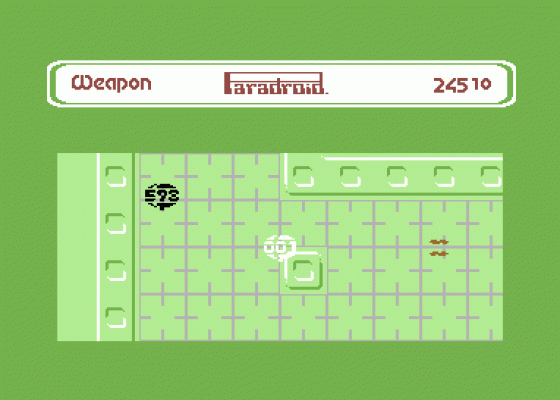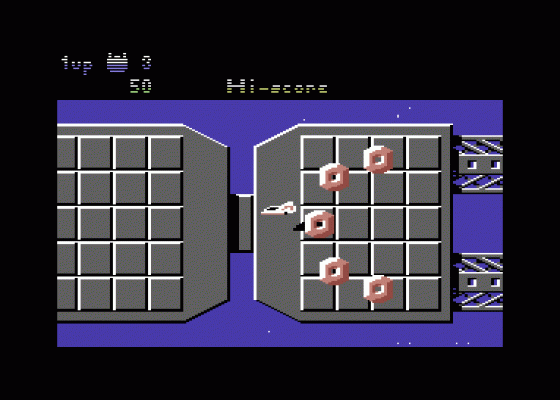
Computer Gamer
 1st February 1987
1st February 1987
Published in Computer Gamer #23
Hewson's latest twin pack offers two games whose effects have been felt far beyond the limits of high tension action
Paradroid/Uridium Twin Pack
Paradroid and Uridium were landmarks of graphic perfection on the Commodore 64 and their realistic 3D images have been copied but never bettered. Acknowledging that times have changed since their first release, Hewson have allowed the programmers to rework their masterpieces to produce one of the best bargains of the decade.
I don't want to sound disparaging when I say that one of the best parts of the new, Paradroid is the loading screen. Andrew Braybrook has grasped the opportunity to show what can be done to relieve the boredom of still-shot loaders. For Paradroid, we are presented with a threatening silhouette of three flashing-eyed droids collected around a console with flickering status indicators. As the load proceeds, the monotonous electronic sounds which accompany the scene are punctuated with the crackling of an electrical storm. The resultant lightning flashes detail onto the screen of three very solid-looking droids, a visual symphony of light and shade.
The game fulfills the promise of the loader and stretches the meaning of a mind game to its ultimate definition. The Paradroid is an 'influence device' which can lock onto and control any droid. The para is only employed in extreme cases of droid manual over-ride. Such an occasion is the current mutiny on a galactic space freighter. The para has been sent in to quell the uprising by control and elimination of the malfunctioning machines.
A standard para has two low-power lasers for defence but these are no match for the powerful higher grades of droid on the freighter. Fortunately the parasitic nature of the control device allows it to take over the powerful droids and utilise their weaponry in the destruction o the mutineers.
Control is established by negating the microcircuitry of the droid but the power struggle has a side effect of eventually destroying the host (as with most parasitic infestations). On colliding with a potential host the computer screen changes to show a circuit board. Various pathways connect with a central panel of LEDs and the idea is to light up or extinguish the majority of them by pulsing a charge through the correct circuits.
Which side of the panel you wish to control is your first choice and you must ascertain the most advantageous side within a few seconds. Some pathways split in two, some have advantageous pulser units or disadvantageous phase inverters. The amount of pulses which you can send depends on the current status of your para's host. Each droid has a place in the hierarchy dependant on its numerical class, the higher the number it carries, the more the pulses that may be used.
Such a system has the obvious drawback that the lower the grade of your para, the less likely that an assault on a powerful droid will succeed. Crafty paradroid controllers will soon learn that the best way to jump up the hierarchy is to attack a high-grade droid and wait until the pulse exchange time limit is almost exhausted. With a bit of luck you will be able to pass enough pulses to overcome the host but failure results in total annihilation of your device and the failure of the mission.
The freighter is displayed in plan view, deck by deck. Some decks are populated by low-grade maintenance and messenger droids, other decks have a strong contingent of battle droids with powerful armaments. As each level is cleared of droids, the automatic energy conservation systems on the ship will power down that level and indicate that this has occured by a darkening of the colour. The order in which you attack each level is entirely up to you.
Old campaigners will be pleased to learn that the new Paradroid is faster than the original game. The messenger droids fairly zip along and the net effect is a greater challenge than the original game.
Uridium has a similar scenario of drama in deep space. Enemy Super-Dreadnoughts have been placed in orbit around fifteen planets in the galactic sector. Each S-D requires a different mineral for its interstellar power units and these minerals are being sucked up at an alarming rate.
Using a Manta Class Space Fighter you are transported to each planet in turn to overcome the S-D's formidable cloak of fighters and eventually destroy the ship and recover as many fuel rods as possible.
Once more the Hewson graphics reign supreme, chiaroscuro effects create realistic 3D images of the Super-Dreadnoughts and their protective fighters. The animation of the Manta is brilliantly conceived and executed, adding up to a deluxe shoot-'em-up without parallel.
From the onset the action is hot but the S-D's are relatively uncomplicated. Wave upon wave of alien craft must be eliminated as they patrol the scrolling surface of the dreadnought. Various aerials and shields protrude upwards towards the TV screen and block the pathway of the Manta so pilots must perform an airborne slalom as they pursue the alien craft.
Some of the dreadnought's surface features can be destroyed for higher scores and when the titanic craft has been beaten into submission you are invited to land on the master runway to embark on the second phase of your mission.
The second part is a fairly straightforward reaction game. A pyramid appears on the screen and horizontally juxtaposed box pairs flash alternately. One box has a value of recovered rods and the other box contains the word QUIT. Pressing the fire button to stop the alternation when the rod value is highlighted is the aim of this game. As the values get higher the alternation speeds up making it more and more difficult to avoid quitting unintentionally.
When you complete this you have one last run at any remaining surface targets which you missed in the first assault, as the dreadnought disintegrates before your eyes.
What Hewson's did was to take the tried and tested genre of the shoot-'em-up and add extra depth and superb graphics to create a whole new dimension to a hackneyed theme.
Once more the compilation version differs from the orignal game by having new dreadnought layouts to challenge the newcomer or the battle-hardened expert.
If the Gamer Gold award has existed when the original versions of these games had been released, then both would already sport this accolade. This maes the combined version doubly desirable and a must for any C64 owner's collection. Even if you're played your old versions into the ground, the new ones on this tape breathe new life into the old games.
Other companies should take note of the complete approach to added functions which is contained in both games. Especially worthy of note is the monochrome mode. Not every computer owner has the advantage of a colour TV and some games are rendered unplayable without chromatic differentiation and my photographer would like to thank both programmers for the pause modes which make his life bearable!
I know that there is something new in the Hewson pipeline which will hopefully be as innovative as these games but, to tide you over until that appears, dash out and buy this and live in envy of your friends.
Scores
Commodore 64/128 Version| Impact | 95% |
| Originality | 95% |
| Playability | 97% |
| X-Factor | 98% |
| Overall | 96% |



